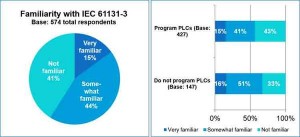 Don’t call it a comeback. Not yet, at least. Programmable logic controllers (PLCs) are plodding through a global economic swamp, but there’s dry land on the horizon.
Don’t call it a comeback. Not yet, at least. Programmable logic controllers (PLCs) are plodding through a global economic swamp, but there’s dry land on the horizon.
In 2015, the PLC market sank by 11.5%, and revenue slid to $8.3 billion, according to the IHS Markit’s PLCs Annual Intelligence Service. The path ahead remains muddy because of the unfavorable economic climate in emerging economies, China’s economic woes, overcapacity in many heavy industries and the end of the commodity super-cycle, the report predicts.
“PLCs perform better than IPCs in industry areas on aspects such as lifecycle, maintenance, reliability and ruggedness and engineering workload.” — Rita Liu, analyst, manufacturing technology, IHS Markit
“The estimates for 2015 and forecast for 2016 are dependent on primary information collected from interviews,” explains Rita Liu, analyst, manufacturing technology, IHS Markit, a U.K.-based intelligence organization. But the international economic climate, especially exchange-rate fluctuations, affects the report statistics. “All price and revenue data for 2014 and 2015 were converted to U.S. dollars using the average exchange rates for the year,” says Liu. “The euro and Japanese yen devalued significantly against U.S. dollars by 19.6% and 14.4%, respectively. In this report, the EMEA and Japanese markets were estimated to have contracted dramatically by 15.8% and 10.6% in U.S. dollars in 2015, despite unit shipments in both markets increasing by 4.1% and 3.0%, respectively. The slower growth of the Chinese economy and overcapacity in most heavy industries also impact the whole Asia-Pacific market for PLCs generally.”
Despite the murky waters, there’s drier ground and higher ground ahead. Global revenue from PLCs and associated software and services should increase at a compound annual growth rate (CAGR) of 3.8% from 2017 to 2020, rising up to $9.3 billion. The largest regional market for PLCs will remain Europe, the Middle East and Africa (EMEA), where one-third of global revenue occurs, according to the IHS Markit report. The Asia-Pacific market will grow the fastest over the next five years, especially from 2018 to 2020, thanks to the fast-growing Indian and southeast Asian markets and a recovering Chinese market tied to South Korean and Taiwanese markets. The American region is expected to be the second-fastest growing market, with recovery beginning in 2017. IHS Markit’s forecast is based on the macro-economy, so it’s aligned with other IHS annual reports on machinery production and capital expenditures.
The real performance of the PLC market however depends on growth in the discrete- and process-manufacturing sectors where PLCs are used. Machine tools, packaging machinery and automotive sectors traditionally have been the three largest markets for PLCs. But these markets, especially the machine-tool sector, are forecast to grow more slowly than the market average from 2015 to 2020. China and the United States, the leading national markets for machine tools, suffered major machine-tool declines in 2015.
In discrete manufacturing, PLCs are growing fastest in the robotic sector, primarily in automotive manufacturing and the electrical and electronics industries. The global robot boom has had a positive impact on PLC revenues because they are core components. Food, beverage and tobacco machinery will be the second-fastest growing sector from 2015 to 2020. In process manufacturing sectors, water and wastewater, pharmaceutical and power-generation sectors are forecast to grow most quickly, according to IHS Markit’s forecast.
As the IT and OT disciplines converge and as HTML5 language and MQTT protocol continue to infiltrate the programmer’s domain, the effects on PLC coding are becoming more tangible. “MQTT is used more at the cloud level and is becoming more important, and also we could envision data from I/Os being sent directly to the cloud, rather than via the PLC, so this would mean I/O products will be a more important part of the overall IoT discussion, and PLCs will be less so,” says Liu.
“To some degree, the faster growth of industrial PCs (IPCs) has some impact on the PLC market, but the impact is not big now or in the following five years,” continues Liu. “Some of the PLC products today have the same PC-based architecture. And some high-end modular PLCs already have a good enough processing ability and various functionality. Additionally, PLCs perform better than IPCs in industry areas on aspects such as lifecycle, maintenance, reliability and ruggedness and engineering workload, so lots of customers are still happy with PLCs.”
Source: http://www.controldesign.com/articles/2016/is-the-plc-ready-for-a-comeback/




